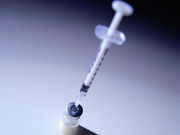Significant increases in hypothalamus; insula, superior temporal gyrus; medial prefrontal cortex
WEDNESDAY, May 11, 2016 (HealthDay News) — For patients with lipodystrophy (LD), resting-state connectivity is significantly increased in three brain areas with metreleptin treatment, with decreased hunger feelings and diminished incentive value of food, according to a study published online May 10 in Diabetes.
Haiko Schlögl, M.D., from the University Hospital Leipzig in Germany, and colleagues performed resting-state functional magnetic resonance imaging scans and extensive behavioral testing during the first 52 weeks of metreleptin treatment in nine patients with LD.
The researchers found that over the course of metreleptin treatment, resting-state connectivity significantly increased in three brain areas: hypothalamus, insula/superior temporal gyrus, and medial prefrontal cortex. During metreleptin therapy, behavioral tests showed that there were significant decreases in perceived hunger, importance of eating, eating frequencies, and liking ratings of food pictures.
“Taken together, leptin substitution was accompanied by long-term changes of hedonic and homeostatic central nervous networks regulating eating behavior, as well as decreased hunger feelings and diminished incentive value of food,” the authors write. “It needs to be assessed in future studies whether metreleptin treatment in LD restores physiological processes important for the development of satiety.”
Copyright © 2016 HealthDay. All rights reserved.








